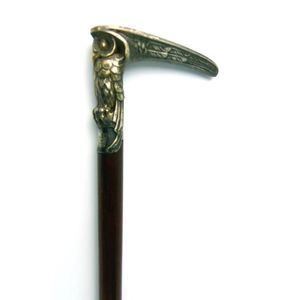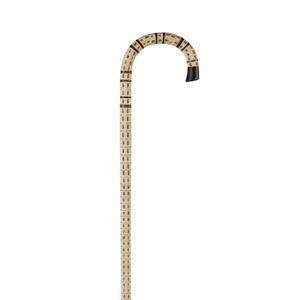Cloisonne Dragon Walking Stick - 19th Century
You must be a subscriber, and be logged in to view price and dealer details.
Subscribe Now to view actual auction price for this item
When you subscribe, you have the option of setting the currency in which to display prices to $Au, $US, $NZ or Stg.
- Bronze - An alloy of copper and tin, traditionally in the proportions of about 9 parts of copper to 1 part of tin.
The discovery of bronze in Western Asia in the 4th century enabled people to create metal objects which were superior to those previoulsy possible because of its strength and hardness, and it has been used throughout the world for weapons, coins, tools, statuary and other decorative items.
It is very fluid in a molten state, and its hardness, strength when set, and non-corrosive properties makes it most suitable for casting sculpture. - Rosewood - A dense timber that varies in shade to very light brown to almost black. When rosewood is cut and sanded the colour of the timber will turn black, and after polishing and exposure to daylight, the surface will gradually lighten over time to light brown with black streaks.
The name comes from the odour emanating from the timber when it is planed, sanded or cut.
Rosewood was very popular for use in Victorian furniture in the second half of the 19th century, and at that time most of the rosewood was imported from Brazil. However it also grows in India and Indonesia.
It is used in the sold for chairs and table legs, but for carcase furniture such as side cabinets and bookcases, and for table tops it is always used as a veneer.
Visually similar items

A silver and cane walking stick with owl detail handle, French, 19th century. 86 cm long

A walking stick, stingray vertebrae and horn, 19th century, 87 cm

A late 19th century Maori carved tokotoko (orator's stick) attributed to Tene Waitere (1854-1931), with three figures carved to the shaft, paua eyes absent, fine lineal and notch decoration to the majority of its length. Length 91 cm. Note: Similar example

A Yimam hook figure (Yipwon), Amancabi Village, Korewari River Region, Papua New Guinea (mid twentieth century), carved wood, 139 cm high. The Leahy family is an important name in the discovery and exploration of Papua New Guinea. Richard Leahy, son of the
